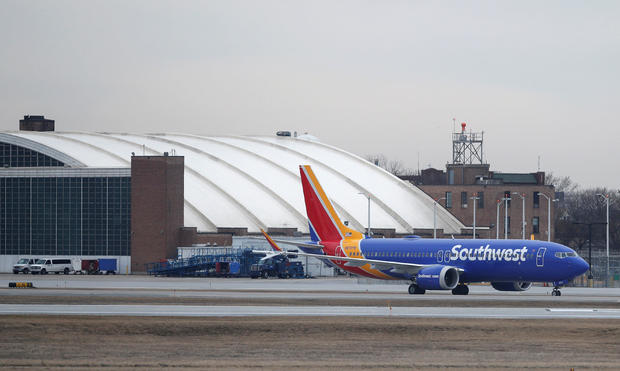A Southwest Airlines Boeing 737 Max 8 being ferried without passengers experienced engine trouble shortly after takeoff, prompting pilots to return to the Orlando International Airport. The plane was heading to Victorville, California.
The plane’s No. 2 engine began to overheat after takeoff, after ingesting debris on the runway which caused a buildup of exhaust. Southwest Airlines says the engine did not blow out.
The Boeing 737 Max 8 aircraft has been under scrutiny following two fatal plane crashes in Indonesia and Ethiopia that showed similarities in flight data, bolstering fears that the cause of the crash may have been due an automatic flight control system unique to the 737 Max 8. It is currently grounded by the FAA for passenger flights, though airline crews are allowed to fly them on so-called ferry flights from one airport to another.
In a statement about Tuesday’s incident Southwest Airlines said: “Southwest 8701 operating as a ferry flight with no passengers onboard returned to Orlando International Airport just before 3pm EDT after Pilots reported a performance issue with one of the engines shortly after takeoff. The Crew followed protocol and safely landed back at the airport. The flight was scheduled to fly to Southern California Logistics Airport in Victorville, Calif., for short-term storage. The Boeing 737 MAX 8 will be moved to our Orlando maintenance facility for a review.”
In a statement, the Federal Aviation Administration (FAA) confirmed Southwest Airlines Flight 8701 was a Boeing 737 Max aircraft and said pilots “declared an emergency after the aircraft experienced a reported engine problem,” before returning and landing safely in Orlando. The FAA confirmed it is investigating the incident.
Boeing’s 737 Max 8 aircraft has become a source of major controversy around the world, with safety officials grounding it internationally and in the United States. While investigators have yet to fully determine the cause of the two crashes — Lion Air Flight 610 on Oct. 29, 2018 and Ethiopian Airlines Flight 302 on March 10, 2019 — anti-stall software added to the 737 Max 8 has become the main point of focus. The MCAS system automatically pushes the plane’s nose down under certain circumstances, potentially surprising pilots who are unfamiliar with the system and overriding their commands.
Boeing and the FAA decided pilots did not need to be informed about the change to the flight control system when the 737 Max 8 rolled out, helping airlines avoid the cost of more extensive retraining of pilots. The Transportation Department is now investigating how the FAA certified the Boeing 737 Max 8 aircraft and approved the MCAS system.
Hours after the incident with the Southwest Airlines jet, Sen. Edward Markey, D-Massachusetts, indicated he plans to submit a letter Wednesday to Boeing’s CEO asking him to respond to several questions concerning the airliner’s Max aircraft, specifically about security features the company provides for an additional fee.
“One feature — the angle of attack indicator — displays the readings of the system’s sensors in the cockpit. The other feature — a disagree light — alerts the pilots if the plane’s sensors are providing different readings, which could help pilots and mechanics detect a sensor malfunction,” the letter reads, which is expected to be co-signed by several of Markey’s colleagues. “The FAA and other aviation regulators did not require these features to come standard on the 737 Max 8 and 9 … We write to request answers about Boeing’s ongoing practice of charging airlines extra for safety-critical systems important to the operation of an aircraft.”
The letter requests Boeing CEO Dennis Muilenburg to respond by April 16.
“Safety must be a standard part of our fleets, engrained in every bolt, sensor, and line of code on an aircraft,” the letter urges. “Boeing should include all safety-critical systems instrumental to the safe operation of an aircraft as part of the standard cost to the airlines of purchasing their aircraft. Safety features on jets that fly hundreds of passengers should never be sold as a la carte add-ons.”
Kris Van Cleave and Peter Martinez contributed to this report.


